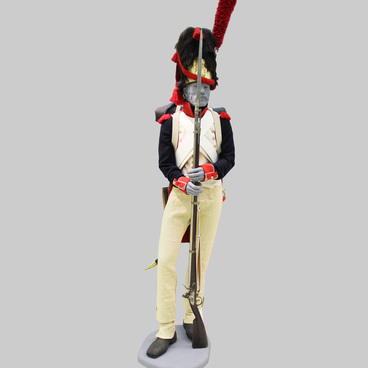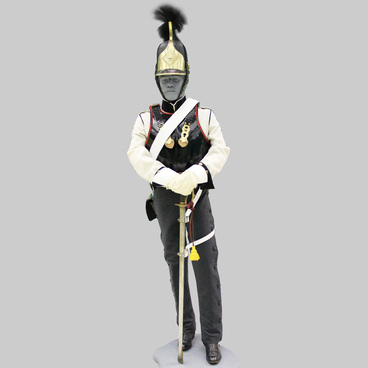The Russian Imperial Guard was elite part of the army charged with obligations related to ensuring the Emperor personal security. The Guard comprised all military services: infantry, cavalry, and artillery. It included also the Life Guard Horse Artillery – independent branch consisting of two batteries.
Horse Artillery was to support the Cavalry in combat and to form a maneuvering artillery reserve. The Horse Artillery crew was trained in not only servicing guns, but also being in action in mounted formation.
We see here a cannoneer of the Life Guard Horse Artillery. Cannoneers were obliged to know how to make various types of artillery charges, to direct and shoot the gun. Cannoneers (gunners) were divided into three classes according to the training degree, this cannoneer is a second class gunner.
It was prescribed to the Life Guard Horse Artillery to wear busbies instead of helmets. This head-dress appeared in the Russian Army in 1803-1805, the cannonneer is wearing the model of 1808. Busbies were made from felt, with leather bordering at the bottom. The emblem on the Guard Artillery busby represented a double-headed eagle on two crossed cannon barrels. To the top of the busby, a hackle was fixed – decoration made from horse hair on a wire base.
Another decorative element – etishket – was woven from linen cord. In the Russian Army, etishkets were red, and for officers they were woven from golden or silver cords. The left etishket was short, reaching down to the busby lower edge, and consisted of two small tassels. The right etishket was longer and had a more complicated weaving pattern.
As bladed weapons, the Guard Horse Artillery was to use sabers. The cannoneer has in his scabbard a cavalry sable of the model of 1807.
In the Battle of Borodino, the 1st company of the Life Guard Horse Artillery participated in the battle at the left wing, near Semyonosky flèches and Semyonoskaya village. The 2nd company, together with the Life Guard Mounted Regiment and Chevalier Guards played an important role in defeating of the Napoleon’s Cavalry swarm attack on the Russian center.
Horse Artillery was to support the Cavalry in combat and to form a maneuvering artillery reserve. The Horse Artillery crew was trained in not only servicing guns, but also being in action in mounted formation.
We see here a cannoneer of the Life Guard Horse Artillery. Cannoneers were obliged to know how to make various types of artillery charges, to direct and shoot the gun. Cannoneers (gunners) were divided into three classes according to the training degree, this cannoneer is a second class gunner.
It was prescribed to the Life Guard Horse Artillery to wear busbies instead of helmets. This head-dress appeared in the Russian Army in 1803-1805, the cannonneer is wearing the model of 1808. Busbies were made from felt, with leather bordering at the bottom. The emblem on the Guard Artillery busby represented a double-headed eagle on two crossed cannon barrels. To the top of the busby, a hackle was fixed – decoration made from horse hair on a wire base.
Another decorative element – etishket – was woven from linen cord. In the Russian Army, etishkets were red, and for officers they were woven from golden or silver cords. The left etishket was short, reaching down to the busby lower edge, and consisted of two small tassels. The right etishket was longer and had a more complicated weaving pattern.
As bladed weapons, the Guard Horse Artillery was to use sabers. The cannoneer has in his scabbard a cavalry sable of the model of 1807.
In the Battle of Borodino, the 1st company of the Life Guard Horse Artillery participated in the battle at the left wing, near Semyonosky flèches and Semyonoskaya village. The 2nd company, together with the Life Guard Mounted Regiment and Chevalier Guards played an important role in defeating of the Napoleon’s Cavalry swarm attack on the Russian center.



